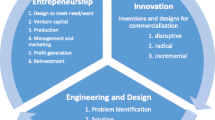Abstract
Many entrepreneurs identify previously ignored consumer needs as an exciting opportunity for new product development. However, it is likely that very few recognize an opportunity for a platform-based approach to new product development to satisfy these needs. When partners Marion and Weinberger embarked on a morning flight out of Philadelphia, they discussed their frustration with cleaning the ice from their windshields. They discussed the problems with current ice scrapers, and by the time they landed in San Francisco, they had developed design criteria and preliminary sketches for an innovative ice scraper. Thus began their quest for building a better ice scraper and using a product platform strategy to target multiple market segments. This case study describes how the team identified market segments and price points along with the development of the principle blade platform and secondary handle platforms, its testing, manufacturing, and production. It also describes how they deliberately designed “hardpoints” for future customization to include as yet unconceived features that might be ascertained from customer feedback after product launch. Included is a description of the partnerships formed to build a virtual company that maximized resources and capabilities yet led to challenges in communication and documentation throughout the platform and product development.
Similar content being viewed by others
References
Aboulafia R. (2000). Airbus pulls closer to Boeing. Aerospace America 38(4): 16–18
Baldwin C.Y., Clark K.B. (2000). Design rules: Volume 1: The power of modularity. Cambridge, MA, MIT Press
Berti S., Germani M., Mandorli F., Otto H.E. (2001). Design of product families – An example within a small and medium-sized enterprise 13th International Conference on Engineer Design (pp. 507–514). Glasgow, UK.
Farrell R.S., Simpson T.W. (2003). Product platform design to improve commonality in custom products. Journal of Intelligent Manufacturing 14, 541–556
Feitzinger E., Lee H.L. (1997). Mass customization at Hewlett-Packard: The power of postponement. Harvard Business Review 75(1): 116–121
Kimberly W. (1999). Back to the future. Automotive Engineer 24(5): 62–64
Lehnerd A.P. (1997). Revitalizing the manufacture and design of mature global products. In: Guile B.R., Brooks H. (eds), Technology and global industry: Companies and nations in the world economy. Washington, D.C., National Academy Press, pp. 49–64
Maupin, A. J., & Stauffer, L. A. (2000). A design tool to help small manufacturers reengineer a product family. Proceedings of the ASME Design Engineering Technical Conferences, Baltimore, Maryland, September 10–13, DETC2000/DTM-14568.
Meyer M.H., Lehnerd A.P. (1997). The power of product platforms: Building value and cost leadership. New York, Free Press
Muffato M. (1999). Introducing a platform strategy in product development. International Journal of Production Economics 60–61: 145–153
Naughton K., Thornton E., Kerwin K., Dawley, H. (1997). Can Honda build a world car? Business Week, Sept. 8, 100(7).
Pine J.B.H. (1993). Standard modules allow mass customization at bally engineering structures. Planning Review 21(4): 20–22
Rothwell R., Gardiner P. (1990). Design commonality to reduce multi-item inventory: Optimal depth of a product line. Operations Research 19(2): 491–509
Sabbagh K. (1996). Twenty-First century jet: The making and marketing of the Boeing 777. New York, Scribner
Sanderson S.W., Uzermeri M. (1997). Managing Product Families. Irwin, Chicago
Simpson T.W. (2004). Product platform design and customization: Status and promise. Artificial Intelligence for Engineering Design, Analysis and Manufacturing 18(1): 3–20
Whitney (1993). Nippondenso Co. Ltd: A case study of strategic product design. Research in Engineering Design 5(1): 1–20
Wilhelm (1997). Platform and modular concepts at Volkswagen – Their effect on the assembly process. In: Shimokawa K., Jurgens U., Fujimoto T. (eds), Transforming automobile assembly: Experience in automation and work organization. New York, Springer, pp. 145–156
Author information
Authors and Affiliations
Corresponding author
Rights and permissions
About this article
Cite this article
Shooter, S.B., Evans, C.M. & Simpson, T.W. Building a better ice scraper—a case in product platforms for the entrepreneur. J Intell Manuf 18, 159–170 (2007). https://doi.org/10.1007/s10845-007-0010-3
Received:
Accepted:
Published:
Issue Date:
DOI: https://doi.org/10.1007/s10845-007-0010-3




